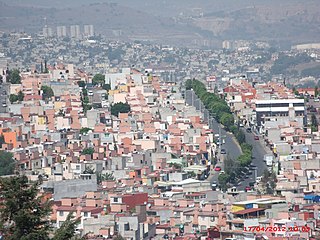
Michoacán, formally Michoacán de Ocampo, officially the Free and Sovereign State of Michoacán de Ocampo, is one of the 31 states which, with the Federal District, comprise the 32 Federal Entities of Mexico. The State is divided into 113 municipalities and its capital city is Morelia. The city was named after José María Morelos, one of the main heroes of the Mexican War of Independence.

The State of Mexico is one of the 32 federal entities of Mexico. It is the most populous, as well as the most densely populated state. It is divided into 125 municipalities and its capital city is Toluca de Lerdo.

Querétaro, officially the Free and Sovereign State of Querétaro, is one of the 32 federal entities of Mexico. It is divided into 18 municipalities. Its capital city is Santiago de Querétaro.
Tepehuanes Municipality is a municipality in the Mexican state of Durango. It is located in the North West of Durango at 25°12'"-26°25'"N 105°23'"-106°40'"W, at an elevation of about 1,830 meters (6000 feet).

Mapimí is a city and municipal seat of the Mapimí Municipality in the Mexican state of Durango. As of 2010, the town of Mapimí had a population of 5,623.

Tultitlán de Mariano Escobedo is the seat of the municipality of Tultitlán located in the northeastern part of the State of México in Mexico. It lies adjacent to the northern tip of the Federal District and is part of the Greater Mexico City urban area. Both the city and the municipality are interchangeably known as San Antonio Tultitlán or simply Tultitlán, a name which comes from Náhuatl meaning "among the tule plants". "de Mariano Escobedo" was added to the city's name in 1902 in honor of the general who fought in the Mexican–American War and for the liberals during the period of La Reforma with Benito Juárez.
Cucurpe is the municipal seat of Cucurpe Municipality in the Mexican state of Sonora.

Tubutama is a town in Tubutama Municipality, in the north-west of the Mexican state of Sonora. Eusebio Kino, SJ, founded Mission San Pedro y San Pablo del Tubutama in 1691. Tubutama was the headquarters of religious administration for the entire Pimería Alta during much of the Jesuit and Franciscan period of Spanish colonial rule.

The Tepehuán Revolt broke out in Mexico in 1616. The Tepehuán Indians attempted to break free from Spanish rule. The revolt was crushed by 1620 after a large loss of life on both sides.

Guachochi is a municipality and a city in the south-western portion of the Mexican state of Chihuahua. The city of Guachochi serves as the municipal seat for the surrounding municipality of the same name.

Carichí is a town in the Mexican state of Chihuahua. It serves as the municipal seat of the surrounding municipality of the same name.

Chínipas de Almada is a town in the south-western portion of the Mexican state of Chihuahua, in the Sierra Madre Occidental. It serves as the municipal seat of the surrounding municipality of Chínipas.

Meoqui is one of the 67 municipalities of Chihuahua, in northern Mexico. The municipal seat lies at Pedro Meoqui. The municipality covers an area of 370 km², making it one of the smallest in the state but one of the most densely populated.

San Francisco Javier de Satevó is a village in the Mexican state of Chihuahua. It serves as the municipal seat for the surrounding municipality of Satevó.

Mezquital is a city and seat of the Municipality of Mezquital in the state of Durango, north-western Mexico. It is situated in the northeast of the municipality, near the boundary with the Municipality of Suchil. As of 2010, the town had a population of 1,742.

San Pablo Huitzo is a town and municipality in Oaxaca in south-western Mexico. The municipality covers an area of 63.80 km². It is part of the Etla District in the Valles Centrales region. As of 2005, the municipality had a total population of 5,242.

Arroyo Seco Municipality is a municipality in Querétaro in central Mexico.

Rayón is a town and municipality in San Luis Potosí in central Mexico.






















